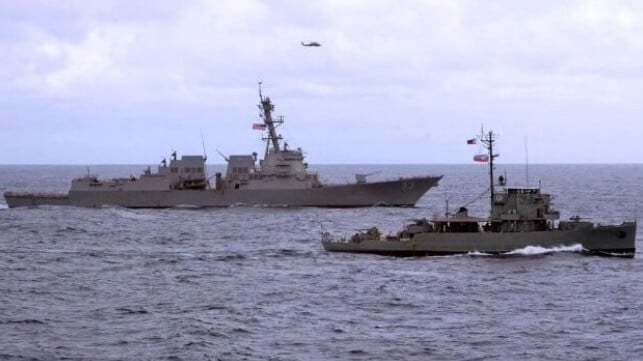US and Philippines Conduct First SINKEX During Joint Exercise

The United States and the Philippines concluded the field portion of their largest-ever bilateral training exercise Balikatan with a series of live-fire training exercises including the first SINKEX conducted during the annual training. The exercise was seen as a show of force for the United States and a strong demonstration of the commitment to the Philippines under the 70-plus-year-old mutual protection agreement.
The exercise started on April 11 and runs for two more days to April 28. It was the largest of the annual joint programs and doubled the participation versus 2022. During all aspects of the nearly three-week exercise, more than 17,600 members of the Armed Forces of the Philippines (AFP) and the U.S. military participated. The U.S. sent 12,200 personnel to train alongside 5,400 members of the Philippines’ forces. The full program was designed to improve the interoperability and capability of the joint forces and included maritime security, amphibious operations, live-fire training, urban and aviation operations, cyber defense, counterterrorism, and disaster relief exercises.
“Balikatan provides unparalleled opportunities to demonstrate the strength and readiness of the Philippine-U.S. security alliance,” said Lt. Col. Daniel Huvane, Balikatan Combined Joint Information Director. “Engagements such as Balikatan are important investments in our ability to work together across the spectrum of military operations, respond to crises, support the people of the Philippines, and accomplish our shared missions.”
In its prepared statements, the U.S. said that this year’s iteration would strengthen the Allies’ ability to plan, coordinate, and provide command and control of forces together against a range of scenarios and simulated challenges. They highlighted that the training event would enable the AFP and the U.S. military to refine tactics, techniques, and procedures related to maritime security, and deconflict fires and maneuver in a shared and contested battlespace.
The “show stopper” however came today with the SINKEX exercise. Philippine President Ferdinand Marcos Jr. and Department of National Defense Officer-in-Charge Carlito Galvez personally attended the events to view the live-fire training and SINKEX which took place in the waters off Central Luzon. The president attended other live-fire exercises which yesterday included the combined forces shooting down simulated cruise missiles and drones with a range of air defense systems.
WATCH:????????????????military forces fired upon and sunk the decommissioned ex-BRP Pangasinan (PS31) off San Antonio, Zambales, on April 26, during the first-ever sinking exercise (SINKEX) for #Balikatan2023 | @cnnphilippines
— David Y. Santos (@davidyusantos) April 26, 2023
???? @PhilAirForce 300th Air Intelligence & Surveillance Wing pic.twitter.com/S0yPsXqBMf
WATCH: @PhilAirForce attack aircraft-- the T-29 ATAK Helicopter & A-29B Super Tucano, both operated by the 15th Strike Wing, also delivered firepower during the SINKEX for #Balikatan2023 on Wednesday | @cnnphilippines
— David Y. Santos (@davidyusantos) April 26, 2023
???? PAF pic.twitter.com/fDv3umJQx4
A World War II-era corvette was selected for the SINKEX. The BRP Pangasinan had been decommissioned by the Philippine Navy in 2021. The vessel was positioned offshore and because of the depth of the waters, 6,000 feet, it was drifting.
The Manila Bulletin reports that Col. Michael Logico, executive agent for the Philippine side of Balikatan 2023, said BRP Pangasinan (PS-31) sank at 2:55 p.m. when an F-35B Joint Strike Fighters aircraft of the U.S. delivered a laser-guided bomb to it. Before that, he said High Mobility Artillery Rocket System (HIMARS) that were fired from land-based positions but failed to sink the vessel. Logico said that was not unexpected because, unlike the airborne assault, the land-based rockets were not precision weapons.
“It will not be fair to give all the credit to the U.S. Air Force because a lot of the other aircraft and navy ships also contributed to the sinking of BRP Pangasinan,” Logico noted. “But what delivered the final salvo was the F-35.”
Approximately 1,400 marines, soldiers, sailors, airmen, and Coast Guard from both countries were involved in this final portion of the field exercises. According to officials, they worked together to detect, identify, target, and engage the target ship. A broad range of ground and air-based weapon systems were involved.

that matters most
Get the latest maritime news delivered to your inbox daily.
According to the report in the Manila Bulletin, the troops had extra real-life practice as two unauthorized “intruders” briefly delayed the SINKEX exercise. First, they detected a private, unregistered aircraft in the vicinity crossing the ocean near the target. They also had to direct a small boat away from the target area before the exercise began.
Balikatan, which was seen as sending an important message and demonstration of force across the region, concludes with two final days of events on land. Both the Americans and Filipinos have already declared it a success that greatly improved relations between the two countries.
